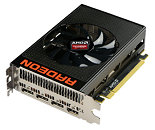- Joined
- Oct 9, 2007
- Messages
- 47,648 (7.44/day)
- Location
- Dublin, Ireland
| System Name | RBMK-1000 |
|---|---|
| Processor | AMD Ryzen 7 5700G |
| Motherboard | Gigabyte B550 AORUS Elite V2 |
| Cooling | DeepCool Gammax L240 V2 |
| Memory | 2x 16GB DDR4-3200 |
| Video Card(s) | Galax RTX 4070 Ti EX |
| Storage | Samsung 990 1TB |
| Display(s) | BenQ 1440p 60 Hz 27-inch |
| Case | Corsair Carbide 100R |
| Audio Device(s) | ASUS SupremeFX S1220A |
| Power Supply | Cooler Master MWE Gold 650W |
| Mouse | ASUS ROG Strix Impact |
| Keyboard | Gamdias Hermes E2 |
| Software | Windows 11 Pro |
There won't be a Radeon R9 Nano review on TechPowerUp. AMD says that it has too few review samples for the press. When AMD first held up the Radeon R9 Nano at its "Fiji" GPU unveil, to us it came across as the most promising product based on the chip, even more than the R9 Fury series, its dual-GPU variant, and the food-processor-shaped SFF gaming desktop thing. The prospect of "faster than R9 290X at 175W" is what excited us the most, as that would disrupt NVIDIA's GM204 based products. Unfortunately, the most exciting product by AMD also has the least amount of excitement by AMD itself.
The first signs of that are, AMD making it prohibitively expensive at $650, and not putting it in the hands of the press, for a launch-day review. We're not getting one, and nor do some of our friends on either sides of the Atlantic. AMD is making some of its tallest claims with this product, and it's important (for AMD) that some of those claims are put to the test. A validated product could maybe even convince some to reach for their wallets, to pull out $650.

Are we sourgraping? You tell us. We're one of the few sites that give you noise testing by some really expensive and broad-ranged noise-testing equipment, and more importantly, card-only power-draw. Our reviews also grill graphics cards through 22 real-world tests across four resolutions, each, and offer price-performance graphs. When NVIDIA didn't send us a GeForce GTX TITAN-Z sample, we didn't care. We didn't make an announcement like this. At $2,999, it was just a terrible product and we never wished it was part of our graphs. Its competing R9 295X2 could be had under $700, and so it continues to top our performance charts.
The R9 Nano, on the other hand, has the potential for greatness. Never mind the compact board design and its SFF credentials. Pull out this ASIC, put it on a normal 20-25 cm PCB, price it around $350, and dual-slot cooling that can turn its fans off in idle, and AMD could have had a GM204-killing product. Sadly, there's no way for us to test that, either. We can't emulate an R9 Nano on an R9 Fury X. The Nano appears to have a unique power/temperature based throttling algorithm that we can't copy.
"Fiji" is a good piece of technology, but apparently, very little effort is being made to put it into the hands of as many people as possible (and by that we mean consumers). This is an incoherence between what AMD CEO stated at the "Fiji" unveil, and what her company is doing. It's also great disservice to the people who probably stayed up many nights to get the interposer design right, or sailing through uncharted territory with HBM. Oh well.
View at TechPowerUp Main Site
The first signs of that are, AMD making it prohibitively expensive at $650, and not putting it in the hands of the press, for a launch-day review. We're not getting one, and nor do some of our friends on either sides of the Atlantic. AMD is making some of its tallest claims with this product, and it's important (for AMD) that some of those claims are put to the test. A validated product could maybe even convince some to reach for their wallets, to pull out $650.

Are we sourgraping? You tell us. We're one of the few sites that give you noise testing by some really expensive and broad-ranged noise-testing equipment, and more importantly, card-only power-draw. Our reviews also grill graphics cards through 22 real-world tests across four resolutions, each, and offer price-performance graphs. When NVIDIA didn't send us a GeForce GTX TITAN-Z sample, we didn't care. We didn't make an announcement like this. At $2,999, it was just a terrible product and we never wished it was part of our graphs. Its competing R9 295X2 could be had under $700, and so it continues to top our performance charts.
The R9 Nano, on the other hand, has the potential for greatness. Never mind the compact board design and its SFF credentials. Pull out this ASIC, put it on a normal 20-25 cm PCB, price it around $350, and dual-slot cooling that can turn its fans off in idle, and AMD could have had a GM204-killing product. Sadly, there's no way for us to test that, either. We can't emulate an R9 Nano on an R9 Fury X. The Nano appears to have a unique power/temperature based throttling algorithm that we can't copy.
"Fiji" is a good piece of technology, but apparently, very little effort is being made to put it into the hands of as many people as possible (and by that we mean consumers). This is an incoherence between what AMD CEO stated at the "Fiji" unveil, and what her company is doing. It's also great disservice to the people who probably stayed up many nights to get the interposer design right, or sailing through uncharted territory with HBM. Oh well.
View at TechPowerUp Main Site









